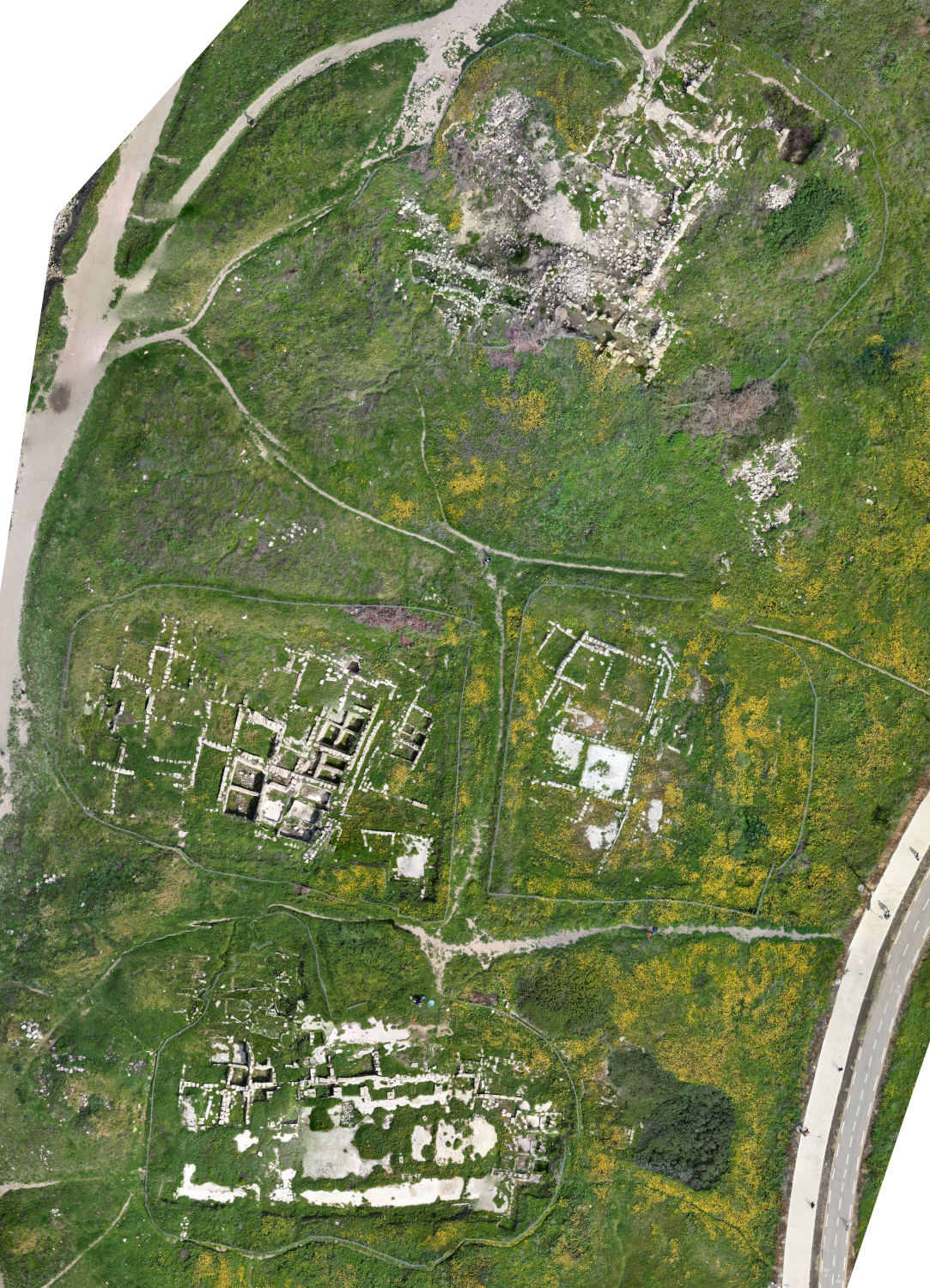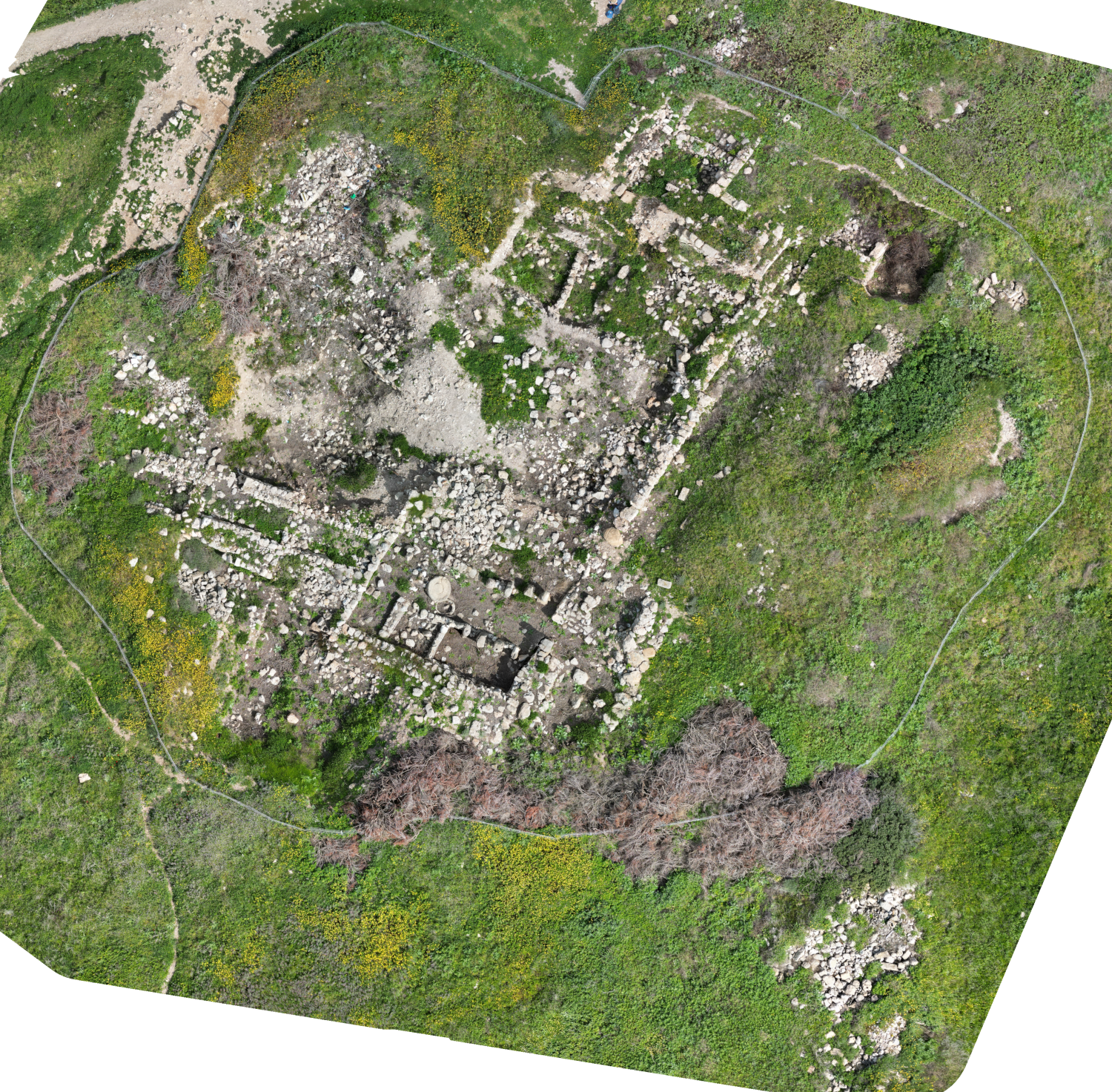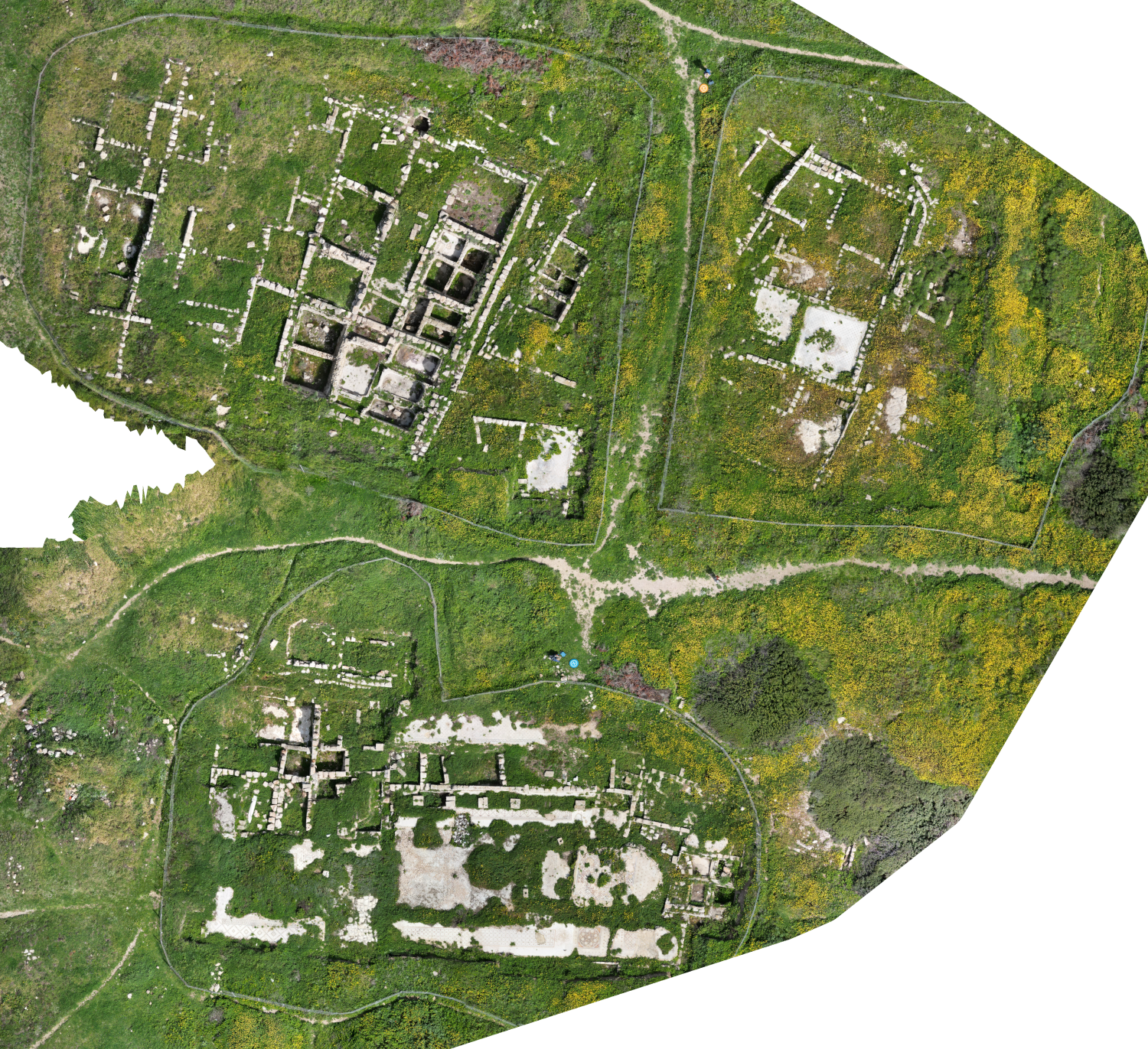Samak (aka Shiqmona)
Click on Image for high resolution magnifiable image
Drone Photo by Jefferson Williams 18 March 2023
| Transliterated Name | Language | Name |
|---|---|---|
| Samak | Arabic | |
| Tell es-Samak | Arabic | تل السمك |
| Tel Shiqmona | Hebrew | תל שִׁקְמוֹנָה |
| Sycamine | Greek/Roman name | |
| Porphyreon | Crusader |
Tel Samak is located on the Mediterranean coast about 1.3 km. southwest of the Carmel Cape. Occupation has been discovered as far back as the Bronze Age and the site contains the remains of a Byzantine town (Joseph Elgavish in Stern et al, 1993). Although this site is often referred to as Shiqmona in the literature, Shiqmona is thought to be located elsewhere and this site is now referred to as Samak (personal communication with Michael Eisenberg, 2023).
Tel Shiqmona (Tell es-Samaq) is on the Mediterranean coast, about 1.3 km (0.8 mi.) southwest of the Carmel Cape (map reference 1462.2478), which is today within the city of Haifa. Its area is more than 2 a. Prior to excavation, it was 12.74 m above sea level at its highest point. The remains of a Byzantine town extend over the flat fields around the mound, at an average altitude of 5m above sea level. The area of dense ancient remains begins in the north, near the bend in the coastline near the mound, reaching the slopes of Mount Carmel in the east and the beginning of the modern Zarfat Road in the south, although isolated remains are found farther south, as well. The maximum extent of the town in Byzantine times was about 55 a. Shiqmona's cemetery is to the east, on the slopes of Mount Carmel; it extends from Elijah's Cave at the cape to the southern boundary of the town. Elijah's Cave is itself part of a sacred precinct that once occupied the Carmel Cape. Although the site has no convenient seaport, there may have been an anchorage farther south, near Kefar Samir, in the sandy coastal belt now known as the Carmel Beach.
In 1895, G. Schumacher reported that the cemetery at Shiqmona had been systematically plundered for two years, until the Turkish authorities intervened. A Byzantine monastery, probably outside the town's built-up area, was excavated in 1951 by M. Dothan, on behalf of the Israel Department of Antiquities and Museums (q.v. Monasteries: Sha'ar ha-'Aliyah). In the 1950s, several additional discoveries were made in the area of the town, including a bronze plaque bearing a Hebrew inscription. Systematic excavations at the site began in 1963, under the direction of J. Elgavish, on behalf of the Haifa Municipal Museum of Ancient Art. They continued until 1979, their seventeenth season.
The Persian period strata were examined mainly in the 1963-1964 seasons. The remains of the Byzantine town in the fields surrounding the mound were uncovered mainly in the 1965, 1966, 1978, and 1979 seasons. The cemetery was systematically excavated in 1967-1968. The 1968-1970 seasons concentrated on the Iron Age II strata, and the 1971-1974 seasons on the Iron Age I strata. Late Bronze Age strata were reached in 1975-1977. The grotto popularly known as Elijah's Cave was explored in 1966 by A. Ovadiah, on behalf of the Archaeological Survey of lsrael; the inscriptions on the cave walls were cleaned and read at that time. Beginning in 1968, important finds were made by fishermen, on the sea bottom near and south of the mound, up to and including the bathing area known today as Dado's Beach (q.v. Marine Archaeology).
An area of about 800 sq m was cleared on the mound, stretching along the southern edge of the ridge and down the southwestern slope. The limestone bedrock was reached at an altitude of 2.4 m above sea level; the building foundations of the lowest stratum rested on virgin soil, 3.3 m above sea level. The sequence revealed by the excavations follows.
- The town was established in the Late Bronze Age I and was occupied continuously until the end of the Late Bronze Age II. Two clearly defined strata from this period were discovered, with five levels of settlement between them, some of which can also be considered occupational strata (beneath the Late Bronze Age II stratum only a trial sounding was made).
- There were three occupational strata from the Iron Age I.
- There was almost continuous settlement through the Iron Age II, comprising five occupational strata.
- A Phoenician town existed on the site in the Persian period, comprising two occupational strata
- In the Persian, Hellenistic, and Roman periods a series of fortresses stood here.
- There are two strata of dwellings from the Byzantine period.
- Annotated Aerial View from
biblewalks.com
- Tel Samak in Google Earth
- Tel Samak on govmap.gov.il
- Site plan from Torge and 'Ad (2012)

 .הנומקש לת לש םייחרזמה םיילושה ךרואל הריפחה יחטש .2 רויא
.הנומקש לת לש םייחרזמה םיילושה ךרואל הריפחה יחטש .2 רויא
Torge and 'Ad (2012) - Fig. 2 - Area A plan from
Torge and 'Ad (2012)

 .םיכתחו תינכת :A חטש .1 תינכת
.םיכתחו תינכת :A חטש .1 תינכת
Torge and 'Ad (2012) - Plan 4 - Area D/E plan
from Torge and 'Ad (2012)

 Plan 4
Plan 4
Area D/E: plan and sections.
Torge and 'Ad (2012)
- Site plan from Torge and 'Ad (2012)

 .הנומקש לת לש םייחרזמה םיילושה ךרואל הריפחה יחטש .2 רויא
.הנומקש לת לש םייחרזמה םיילושה ךרואל הריפחה יחטש .2 רויא
Torge and 'Ad (2012) - Fig. 2 - Area A plan from
Torge and 'Ad (2012)

 .םיכתחו תינכת :A חטש .1 תינכת
.םיכתחו תינכת :A חטש .1 תינכת
Torge and 'Ad (2012) - Plan 4 - Area D/E plan
from Torge and 'Ad (2012)

 Plan 4
Plan 4
Area D/E: plan and sections.
Torge and 'Ad (2012)
Barzilay (2012) noted that
previous excavations at Tel Shiqmona have indicated that the Byzantine city was constructed in the late sixth century following the destruction of an earlier city in the fourth century, and that an abrupt and violent event caused the demolition of Shiqmona again during the seventh century. According to the damage patterns, it is likely that the structure in Area A was devastated by an earthquake. If so, the local intensity of the earthquake would have been over I = VII (MSK- 64 scale).However, Barzilay (2012) also noted that
it is uncertain whether this damage was caused by an earthquake or by the accumulative effect of the swelling and shrinking soil. However, soil movement due to the swelling and shrinking process is very slow and causes random damage, and repairs would probably be detected in various parts of the building. Based on the criteria presented above, the deformations are consistent with seismic damage.Barzilay (2012) referred to an excavation report by Torge and 'Ad (2012). Torge (personal communication, 2021) attributed the deformations to the active clay soil:
The structures in Shiqmona were built into clay soil which is very active. The builders knew that and changed the soil within the boxes they built as foundations. I believe that because of the boxes technique, the damage appears as it is. In the corners it simply had nowhere to move and so it compressed the stones upwards and broke them.Taxel (2013:79-80) also cast doubt on the possibility that the site was damaged by an earthquake leading to it's abandonment.
- This archaeoseismic evidence is debated. Hagit Torge, the original excavator, disputes a seismic origin and ascribes wall deformations to active soil (personal communication, 2021). Taxel (2013:79-80) casts doubt as to whether the observed deformations have a seismic origin
| Effect | Location | Image(s) | Observation |
|---|---|---|---|
| Displaced Walls Rotated Stones Uplifted Stones Tilted Walls Folded Walls |
Area A
 .םיכתחו תינכת :A חטש .1 תינכת
.םיכתחו תינכת :A חטש .1 תינכת
Torge and 'Ad (2012) |
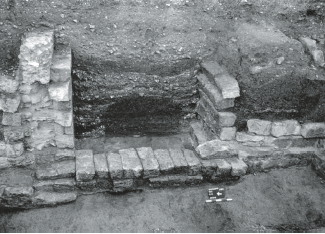
 Fig. 3
Fig. 3Foundations and layers of fill in the northern part of Area A, looking southeast; in foreground, W3. Torge and 'Ad (2012) 
 Fig. 4
Fig. 4Wall 8b in Area A, looking southwest. Torge and 'Ad (2012) 
 Fig. 5
Fig. 5The corner formed by W5 (opposite) and W8a (left) in Area A, looking northeast. In foreground to left, the bedrock foundation of the box. Torge and 'Ad (2012) 
 Fig. 6
Fig. 6Walls 8c and 8d in Area A, looking southwest. Torge and 'Ad (2012) |
|
| Deformed Foundations | Area D/E
 Plan 4
Plan 4Area D/E: plan and sections. Torge and 'Ad (2012) 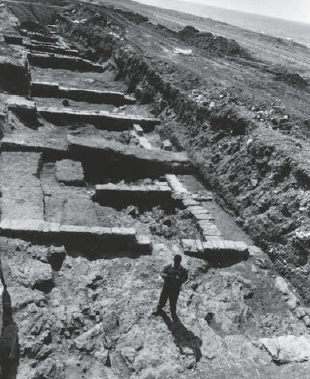
 Fig. 11
Fig. 11The building in Area D/E, general view, looking southeast. On left, the foundation of the mosaic pavement (L420). Torge and 'Ad (2012) 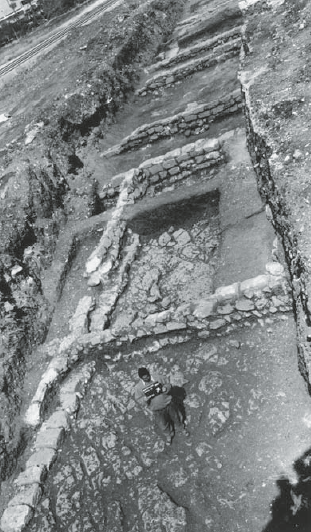
 Fig. 12
Fig. 12Area D/E, general view, looking north. Torge and 'Ad (2012) |
|
- Modified by JW from Fig. 2 of Torge and 'Ad (2012)
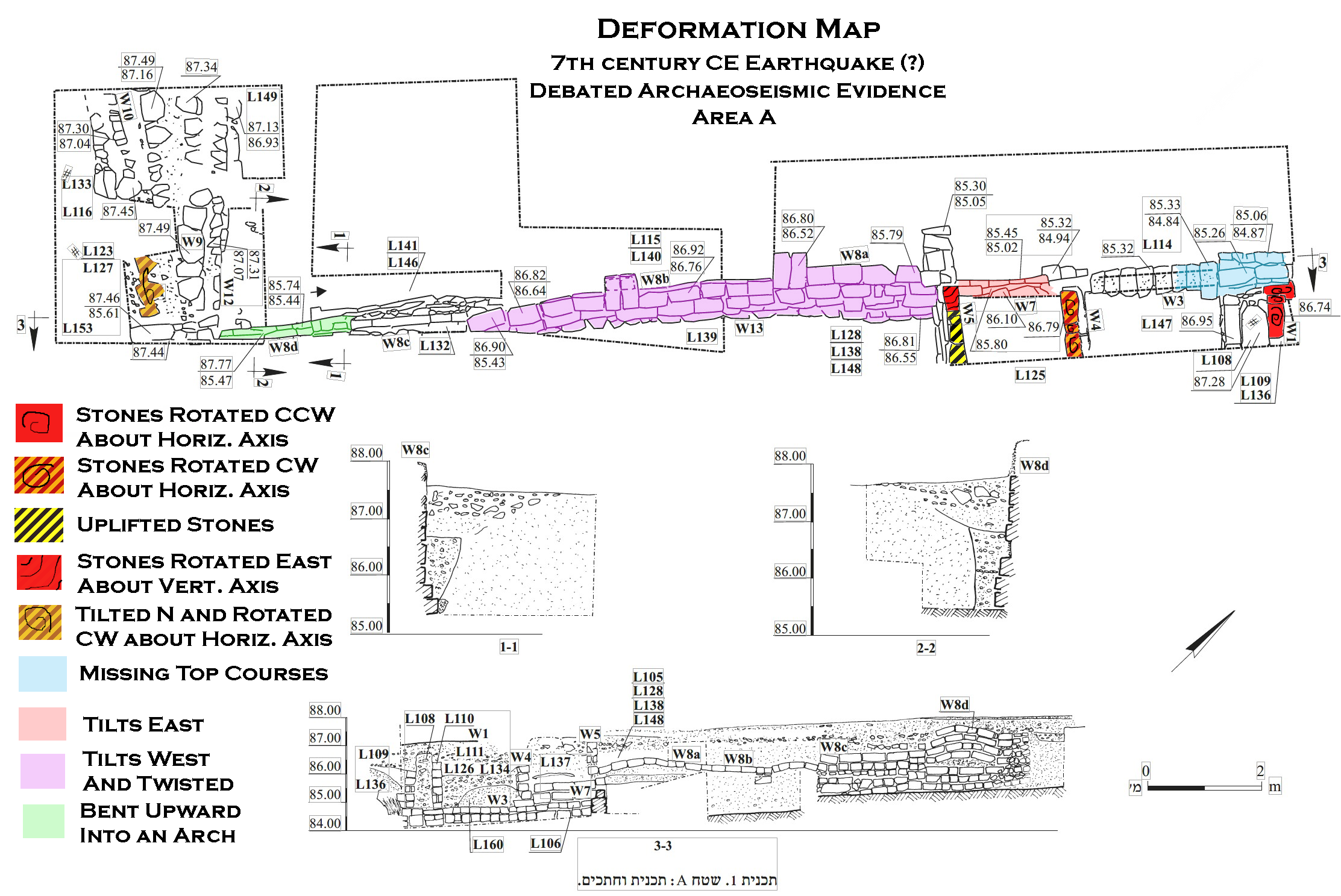 Deformation Map
Deformation Mapmodified by JW from Fig. 2 of Torge and 'Ad (2012)
The Deformation Map shows that the displaced walls are due to vertical uplift and suggest an expansive active soil as the cause. If an earthquake caused the chaotic deformation patterns shown in the map, the site would have to have been above the hypocenter of a powerful earthquake which seems unlikely. If this was the case, more extensive deformation and collapse would be expected form this site and nearby sites and the local Intensity would have been IX (9) or higher. Thus, I agree with Hagit Torge (personal communication, 2021) and Taxel (2013:79-80) that a seismic origin for the observed deformations is not likely.
Barzilay (2012) estimated an Intensity of VII+ (7+) (MSK- 64 scale).
| Description | Flight Date | Pilot | Processing | Downloadable Link |
|---|---|---|---|---|
| Entire Site | 18 March 2023 | Jefferson Williams | ODM - no GCPs | Right Click to download. Then unzip |
| North part of Site | 18 March 2023 | Jefferson Williams | ODM - no GCPs | Right Click to download. Then unzip |
| South part of Site | 18 March 2023 | Jefferson Williams | ODM - no GCPs | Right Click to download. Then unzip |
Barzilay, E. (2012). "Was Shiqmona Devastated by an Earthquake in the Seventh Century CE?" 'Atiqot 72: 53*-55*.
Taxel, I. (2013). "The Byzantine-early Islamic transition on the Palestinian coastal plain: a re-evaluation of the archaeological evidence." Semitica et Classica 6: 73-106.
Torge, H. and U. 'Ad (2012). "Late Byzantine Buildings on the Eastern Fringes of Tel Shiqmona." 'Atiqot/עתיות: (in Hebrew)
J. E1gavish, The Excavations of Shikmona: A Seleucian Garrison Camp from Hasmonean
Times, Haifa 1972
J. Elgavish, Shiqmona on the Seacoast of Mount Carmel, Tel Aviv 1994 (Heb.)
B. Galil
et al., Shikmona, Between Carmel and Sea, Haifa 2001
J. E1gavish, The Excavations ofShikmona: A Seleucian Garrison Campfrom Hasmonean Times, Haifa 1972
B. Lifshitz, ZDPV78 (1962), 84-85; J. E1gavish, An Archaeological Trip into the Past of the
City through Excavations at Shikmona, Haifa 1967
id., RB 75 (1968), 416-417
76 (1969), 412-413
77
(1970), 386-387
78 (1971), 419-422
81 (1974), 98-100
82 (1975), 587-591
83 (1976), 270-272
84
(1977), 264-266
85 (1978), 408-409
86 (1979), 449-450
89 (1982), 238-240
id., !EJ !9 (1969), 247-248;
20 (1970), 229-230
22 (1972), 167
23 (1973), 117-ll8
24 (1974), 283-284
25 (1975), 257-258
26 (1976),
65-76
27 (1977), 166-167
28 (1978), 122-123, 280-281
30 (1980), 208-209
id., Raggi9 (1969), H7;
F. M. Cross, Jr.,IEJ18 (1968), 226-233
C. Novak, Antike Welt 1/3 (1970), 54
A. Spycket, RES! (1974),
258-259
A. Lemaire, Semitica 30 (1980), 17-32
A. Van den Brdnden, Bibbia e Oriente 22 (1980), 219-
225
R. Giveon, Gottinger Miszellen 44 (1981), 17-20
J. Naveh, IEJ 37 (1987), 28-30
N. Karmon and
E. Spanier, ibid. 38 (1988), 184-186
Weippert 1988 (Ortsregister)
G. Finkie1sztejn, RB96 (1989), 224-
234.
J. Elgavish, Shiqmona on the Seacoast of Mount Carmel, Tel Aviv 1994 (Heb.)
B. Galil
et al., Shikmona, Between Carmel and Sea, Haifa 2001
A. Bar-Shay, 5th International Colloquium on Ancient Mosaics, Bath, 5–12.9.1987 (JRA Suppl.
Series 9
eds. P. Johnson et al.), 1–2, Ann Arbor, MI 1994–1995, 113–124
IEJ 45 (1995), 79–80 (Review)
T.
Velmans, Byzantine East, Latin West: Art-Historical Studies (K. Weitzmann Fest.
eds. C. Moss & K. Kiefer),
Princeton, NJ 1995, 309–319
J. Elgavish, OEANE, 5, New York 1997, 36–37
E. Stern, Michmanim 11
(1997), 65*–66*
id., Ki Baruch Hu: Ancient Near Eastern, Biblical and Judaic Studies (B. A. Levine Fest.;
eds. R. Chazan et al.), Winona Lake, IN 1999, 635
Y. Hirschfeld, ESI 18 (1998), 19–20
S. J. Allen, BASOR
315 (1999), 55–58
J. Elayi & H. Sayegh, Port, Paris 1998–2000
M. Bietak & K. Kopetzky, Synchronisation, Wien 2000, 122
J. Bremen, R.I.M.S. News, Report 27 (2000), 23–24
E. Galili & J. Sharvit, ESI 112
(2000), 117*
id., Pirates: The Skull and Crossbones (The National Maritime Museum), Haifa 2002, 146;
id., Tropis VIII: Proceedings of the 8th International Symposium on Ship Construction in Antiquity, Hydra,
Greece, Athens 2002, 199–211
J. Mlynarczyk, ASOR Newsletter 50/3 (2000), 17–18
B. Bagatti, Ancient
Christian Villages of Galilee (SBF Collectio Minor 37), Jerusalem 2001, 87–88
D. Ben-Tor & R. Bonfil,
Beer-Sheva 15 (2002), 29–55
R. Kletter, ESI 114 (2002), 24*–26*
A. Faust, Levant 35 (2003), 123–138
Y.
Olami et al., Map of Haifa-West (22) (Archaeological Survey of Israel), Jerusalem 2003, 28*–32*
H. Torgë
& U. ‘Ad, ESI 115 (2003), 19*–20*
M. Artzy, Aegaeum 25 (2005), 355–361.



